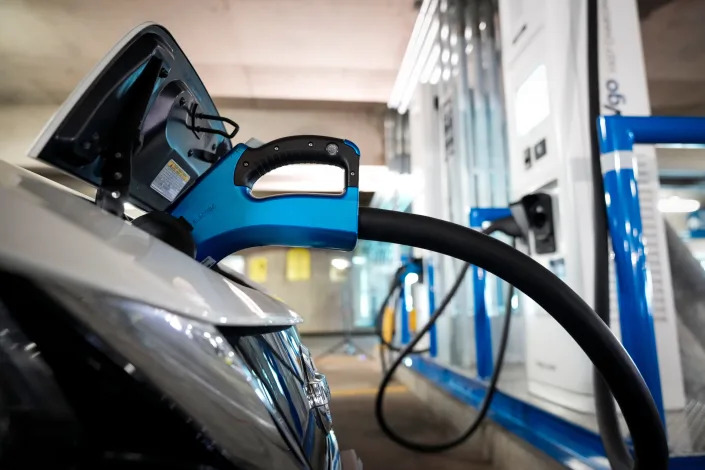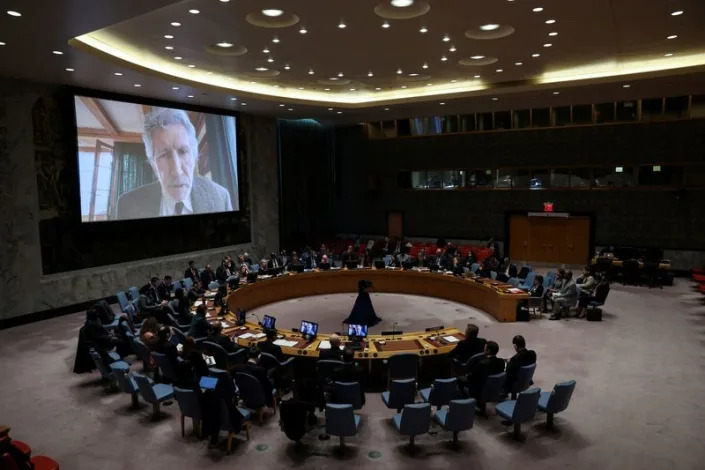Neri Zilber
CHRISTIAN SCIENCE MONITOR
Thu, February 9, 2023
Late last month, after a Palestinian gunman opened fire on worshippers leaving Friday night prayers in a Jerusalem synagogue, Israel’s new national security minister hurriedly left his Sabbath dinner table and rushed to the site.
The security minister, Itamar Ben-Gvir, a key far-right figure in Prime Minister Benjamin Netanyahu’s month-old coalition government, was for years a regular visitor to scenes of grisly terror attacks. Inevitably he would slam the Israeli authorities for being weak, demand harsher measures be taken, and generally fan the flames of the Israeli-Palestinian conflict.
Yet this time was different. Mr. Ben-Gvir, head of the ultranationalist Jewish Power party, was now the authority.
“This happened on your watch! Let’s see you now! Jewish blood isn’t cheap!” the crowd yelled angrily at the politician who has built his political career on promises of forcefully putting down Palestinian terror.
“I hear you. You’re right, you’re right,” Mr. Ben-Gvir responded to the crowd. “The burden of proof is on us, and we need to act now and respond, because it can’t go on like this.”
The Jan. 27 attack in northern East Jerusalem, which killed seven people, was the country’s deadliest since 2011. It came a day after a particularly lethal raid by the Israeli military in the West Bank city of Jenin that claimed the lives of 10 Palestinians, including an older woman. Israeli authorities say most of those killed were armed militants.
In the past year more than 200 Palestinians have been killed in the West Bank – around 40 since the start of 2023 – in what has been a marked escalation on both sides that began with a wave of Palestinian attacks last spring that claimed the lives of more than 30 Israelis.
It was all supposed to be different under this new government, widely considered the most right-wing in Israeli history. Mr. Netanyahu and his ultranationalist allies, especially Mr. Ben-Gvir and the pro-settler Finance Minister Bezalel Smotrich, prevailed in the November election by slamming the previous government for purportedly failing to protect the citizenry and being beholden to left-wing and Arab-Israeli parties. They promised they could do much better.
“When terrorism meets weakness, it raises its head,” Mr. Netanyahu said last May, demanding that the government resign. “Hamas [the Palestinian militant group] sees a weak government that depends on supporters of terrorism and is unable to fight terrorism, strike Hamas officials, and restore peace and security to the citizens of Israel,” Mr. Netanyahu complained.
An unyielding reality
Yet the attacks have continued even on Mr. Netanyahu’s watch. And despite the heightened rhetoric and bold campaign pledges, analysts and former officials point out that the current government’s policies have not – as of yet – deviated greatly from what has been tried in the past.
In recent weeks, not least due to pressure from the Biden administration, Mr. Netanyahu has also managed to keep at bay his more radical senior ministers.
“This may be a ‘fully fully’ right-wing government, but reality [of the Israeli-Palestinian conflict] doesn’t change,” says Col. Michael Milshtein, a former senior Israeli military adviser on Palestinian affairs and a current lecturer at both Tel Aviv and Reichman universities. “The government on the whole doesn’t want a complete explosion – although perhaps Ben-Gvir and Smotrich may want it – and they also don’t want to get into a clash with the U.S.”
In the wake of the Jerusalem attack and two shooting attacks the following day, which wounded two more Israelis, the Israeli Cabinet announced a series of steps, some predictable and others (so far) merely words:
Security forces nationally were put on the highest alert, and military patrols were increased in both Jerusalem and the West Bank.
The family homes of two Palestinian perpetrators in East Jerusalem were quickly sealed ahead of expected demolition – a controversial and long-standing Israeli practice meant to deter future attacks. The international legal community considers such demolitions a form of illegal collective punishment; Israeli security officials are split on whether they are a deterrent, or simply perpetuate a cycle of enmity and violence.
In the West Bank, a major Israeli military operation continued, as it has since last year, with near daily arrest raids into Palestinian towns and refugee camps. One such operation over the weekend, near Jericho, claimed the lives of five Hamas militants who Israel alleges were behind a recent shooting attack.
Mr. Ben-Gvir, in his role overseeing both the police and prisons, proudly announced that he had removed fresh pita bread baking privileges from Palestinian security prisoners, among other smaller steps meant to harden conditions for those jailed on terrorism charges.
The moves, according to Israeli intelligence officials, partly explained renewed rocket fire from Gaza into southern Israel. Like its predecessor, the Netanyahu government responded narrowly, by bombing a few Hamas military installations. No casualties were reported on either side.
“They’re doing a lot of what we were doing, just attaching to it destructive extremist rhetoric,” says one senior Israeli official from the previous government. “In other words, they’re paying all the cost of their rhetoric, especially internationally and among Palestinians, but with zero security benefits or even a significant change in policy.”
Practical constraints
The heightened rhetoric in recent weeks has included vows to loosen gun permit laws for Israeli civilians, a move that so far has been stymied by government bureaucracy (to say nothing of security establishment fears about flooding the country with weapons).
Promises to deny residency status or social security benefits to families of Palestinian attackers in East Jerusalem have so far not moved ahead and are in any event legally dubious.
Plans to demolish Palestinian homes in East Jerusalem and the West Bank that Israeli authorities claim were built without legal permits – nearly impossible for Palestinians to obtain – have been postponed due to international pressure and fears that it would only escalate tensions.
And most tellingly, government promises of increased settlement construction in the West Bank – cast as an “appropriate Zionist response” to the recent attacks – have yet to move ahead. Last month Mr. Netanyahu sided with the military against his hard-line ministers and approved the removal of a wildcat settlement outpost hastily erected by far-right settlers.
Part of the Israeli restraint, or at least hesitation, according to analysts, was due to the presence in the region last week of U.S. Secretary of State Antony Blinken, who urged both Israel and the Palestinian Authority to “take urgent steps to restore calm, to de-escalate.” Mr. Blinken made clear that the Biden administration opposed settlement expansion, the legalization of illegal outposts, and demolitions and evictions.
Yet the mere existence of this far-right Israeli government, combined with its hard-line words, is itself a major obstacle to any real easing of tensions, according to Ibrahim Dalalsha, director of the Horizon Center, a Ramallah-based Palestinian think tank.
“For the Palestinian Authority, Netanyahu and Ben-Gvir are an impediment. The Palestinian public believes this Israeli government needs to be confronted and so [the PA leadership] can’t be seen to do their bidding,” Mr. Dalalsha says, alluding to a proposed Palestinian security crackdown on West Bank militants. “Under the current circumstances, it would be political suicide.”
Netanyahu’s balancing act
A question remains as to whether Mr. Netanyahu’s reluctance to incur U.S. opprobrium will continue to outweigh the right-wing political pressure he is under.
Already, coalition backbenchers and local officials are grumbling about the gap between the Netanyahu ministers’ rhetoric while in opposition and their actions now in government. Mr. Ben-Gvir himself has felt the need to say publicly that if he saw he wasn’t having any influence on policy he would resign. Mr. Smotrich, for his part, is adamant that settlements will soon be expanded.
According to Colonel Milshtein there are two conflicting agendas on the Palestinian issue within the new Israeli government: one led by religious ultranationalists like Messrs. Ben-Gvir and Smotrich, and the other led by the more pragmatic Mr. Netanyahu and his Likud party.
“Netanyahu’s primary goal is to keep things as they were, to not bring about the collapse of the PA, to get to Ramadan and Passover [in late March, a period traditionally marked by escalated violence] with things on the ground calmer – and also not to destabilize the government from within,” says Colonel Milshtein. “It’s not easy. The first group’s agenda could still lead to a conflagration.”
Much will likely depend on events beyond the control of Mr. Netanyahu, his ministers, the PA, or even the Biden administration. According to Mr. Dalalsha, the Israeli-Palestinian conflict has its own uniquely tragic and often bloody logic.
“With or without U.S. intervention, violence goes up and down. It’s a matter of luck and almost irrelevant,” Mr. Dalalsha says. “These are deep-rooted problems.”
Related stories
Palestinians see fewer paths to safety amid violence with Israel
Thu, February 9, 2023
Late last month, after a Palestinian gunman opened fire on worshippers leaving Friday night prayers in a Jerusalem synagogue, Israel’s new national security minister hurriedly left his Sabbath dinner table and rushed to the site.
The security minister, Itamar Ben-Gvir, a key far-right figure in Prime Minister Benjamin Netanyahu’s month-old coalition government, was for years a regular visitor to scenes of grisly terror attacks. Inevitably he would slam the Israeli authorities for being weak, demand harsher measures be taken, and generally fan the flames of the Israeli-Palestinian conflict.
Yet this time was different. Mr. Ben-Gvir, head of the ultranationalist Jewish Power party, was now the authority.
“This happened on your watch! Let’s see you now! Jewish blood isn’t cheap!” the crowd yelled angrily at the politician who has built his political career on promises of forcefully putting down Palestinian terror.
“I hear you. You’re right, you’re right,” Mr. Ben-Gvir responded to the crowd. “The burden of proof is on us, and we need to act now and respond, because it can’t go on like this.”
The Jan. 27 attack in northern East Jerusalem, which killed seven people, was the country’s deadliest since 2011. It came a day after a particularly lethal raid by the Israeli military in the West Bank city of Jenin that claimed the lives of 10 Palestinians, including an older woman. Israeli authorities say most of those killed were armed militants.
In the past year more than 200 Palestinians have been killed in the West Bank – around 40 since the start of 2023 – in what has been a marked escalation on both sides that began with a wave of Palestinian attacks last spring that claimed the lives of more than 30 Israelis.
It was all supposed to be different under this new government, widely considered the most right-wing in Israeli history. Mr. Netanyahu and his ultranationalist allies, especially Mr. Ben-Gvir and the pro-settler Finance Minister Bezalel Smotrich, prevailed in the November election by slamming the previous government for purportedly failing to protect the citizenry and being beholden to left-wing and Arab-Israeli parties. They promised they could do much better.
“When terrorism meets weakness, it raises its head,” Mr. Netanyahu said last May, demanding that the government resign. “Hamas [the Palestinian militant group] sees a weak government that depends on supporters of terrorism and is unable to fight terrorism, strike Hamas officials, and restore peace and security to the citizens of Israel,” Mr. Netanyahu complained.
An unyielding reality
Yet the attacks have continued even on Mr. Netanyahu’s watch. And despite the heightened rhetoric and bold campaign pledges, analysts and former officials point out that the current government’s policies have not – as of yet – deviated greatly from what has been tried in the past.
In recent weeks, not least due to pressure from the Biden administration, Mr. Netanyahu has also managed to keep at bay his more radical senior ministers.
“This may be a ‘fully fully’ right-wing government, but reality [of the Israeli-Palestinian conflict] doesn’t change,” says Col. Michael Milshtein, a former senior Israeli military adviser on Palestinian affairs and a current lecturer at both Tel Aviv and Reichman universities. “The government on the whole doesn’t want a complete explosion – although perhaps Ben-Gvir and Smotrich may want it – and they also don’t want to get into a clash with the U.S.”
In the wake of the Jerusalem attack and two shooting attacks the following day, which wounded two more Israelis, the Israeli Cabinet announced a series of steps, some predictable and others (so far) merely words:
Security forces nationally were put on the highest alert, and military patrols were increased in both Jerusalem and the West Bank.
The family homes of two Palestinian perpetrators in East Jerusalem were quickly sealed ahead of expected demolition – a controversial and long-standing Israeli practice meant to deter future attacks. The international legal community considers such demolitions a form of illegal collective punishment; Israeli security officials are split on whether they are a deterrent, or simply perpetuate a cycle of enmity and violence.
In the West Bank, a major Israeli military operation continued, as it has since last year, with near daily arrest raids into Palestinian towns and refugee camps. One such operation over the weekend, near Jericho, claimed the lives of five Hamas militants who Israel alleges were behind a recent shooting attack.
Mr. Ben-Gvir, in his role overseeing both the police and prisons, proudly announced that he had removed fresh pita bread baking privileges from Palestinian security prisoners, among other smaller steps meant to harden conditions for those jailed on terrorism charges.
The moves, according to Israeli intelligence officials, partly explained renewed rocket fire from Gaza into southern Israel. Like its predecessor, the Netanyahu government responded narrowly, by bombing a few Hamas military installations. No casualties were reported on either side.
“They’re doing a lot of what we were doing, just attaching to it destructive extremist rhetoric,” says one senior Israeli official from the previous government. “In other words, they’re paying all the cost of their rhetoric, especially internationally and among Palestinians, but with zero security benefits or even a significant change in policy.”
Practical constraints
The heightened rhetoric in recent weeks has included vows to loosen gun permit laws for Israeli civilians, a move that so far has been stymied by government bureaucracy (to say nothing of security establishment fears about flooding the country with weapons).
Promises to deny residency status or social security benefits to families of Palestinian attackers in East Jerusalem have so far not moved ahead and are in any event legally dubious.
Plans to demolish Palestinian homes in East Jerusalem and the West Bank that Israeli authorities claim were built without legal permits – nearly impossible for Palestinians to obtain – have been postponed due to international pressure and fears that it would only escalate tensions.
And most tellingly, government promises of increased settlement construction in the West Bank – cast as an “appropriate Zionist response” to the recent attacks – have yet to move ahead. Last month Mr. Netanyahu sided with the military against his hard-line ministers and approved the removal of a wildcat settlement outpost hastily erected by far-right settlers.
Part of the Israeli restraint, or at least hesitation, according to analysts, was due to the presence in the region last week of U.S. Secretary of State Antony Blinken, who urged both Israel and the Palestinian Authority to “take urgent steps to restore calm, to de-escalate.” Mr. Blinken made clear that the Biden administration opposed settlement expansion, the legalization of illegal outposts, and demolitions and evictions.
Yet the mere existence of this far-right Israeli government, combined with its hard-line words, is itself a major obstacle to any real easing of tensions, according to Ibrahim Dalalsha, director of the Horizon Center, a Ramallah-based Palestinian think tank.
“For the Palestinian Authority, Netanyahu and Ben-Gvir are an impediment. The Palestinian public believes this Israeli government needs to be confronted and so [the PA leadership] can’t be seen to do their bidding,” Mr. Dalalsha says, alluding to a proposed Palestinian security crackdown on West Bank militants. “Under the current circumstances, it would be political suicide.”
Netanyahu’s balancing act
A question remains as to whether Mr. Netanyahu’s reluctance to incur U.S. opprobrium will continue to outweigh the right-wing political pressure he is under.
Already, coalition backbenchers and local officials are grumbling about the gap between the Netanyahu ministers’ rhetoric while in opposition and their actions now in government. Mr. Ben-Gvir himself has felt the need to say publicly that if he saw he wasn’t having any influence on policy he would resign. Mr. Smotrich, for his part, is adamant that settlements will soon be expanded.
According to Colonel Milshtein there are two conflicting agendas on the Palestinian issue within the new Israeli government: one led by religious ultranationalists like Messrs. Ben-Gvir and Smotrich, and the other led by the more pragmatic Mr. Netanyahu and his Likud party.
“Netanyahu’s primary goal is to keep things as they were, to not bring about the collapse of the PA, to get to Ramadan and Passover [in late March, a period traditionally marked by escalated violence] with things on the ground calmer – and also not to destabilize the government from within,” says Colonel Milshtein. “It’s not easy. The first group’s agenda could still lead to a conflagration.”
Much will likely depend on events beyond the control of Mr. Netanyahu, his ministers, the PA, or even the Biden administration. According to Mr. Dalalsha, the Israeli-Palestinian conflict has its own uniquely tragic and often bloody logic.
“With or without U.S. intervention, violence goes up and down. It’s a matter of luck and almost irrelevant,” Mr. Dalalsha says. “These are deep-rooted problems.”
Related stories
Palestinians see fewer paths to safety amid violence with Israel







